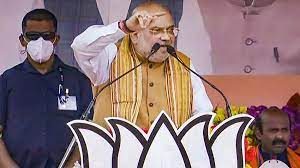India’s overall exports in FY24, a year that was fraught with geopolitical challenges from the ongoing Russia-Ukraine war to simmering tensions in the Middle East, are expected to have surpassed the previous year’s record-high by $280 million to touch $776.68 billion.
Read More: Wholesale inflation logs 3-month high
In fact, India closed its account for the previous financial year registering the lowest merchandise trade deficit in 11 months, at $15.6 billion, in March 2024.
New Delhi was able to limit the impact of the unfolding geopolitical tensions over land and sea, such as the crisis in the Red Sea route, which pushed up shipping costs for Indian exporters as they were forced to take a longer path around the Cape of Good Hope (Africa).
Credit goes to new and emerging areas of Indian exports. Outbound shipments of electronic goods, where India has traditionally been weaker, grew 24 percent due to government initiatives such as the Production Linked Incentive (PLI) scheme and other “Make in India” efforts. Smartphone exports are expected to rise by 30 percent to over $15 billion, points out Global Trade Research Initiative (GTRI) co-founder Ajay Srivastava.
Other goods exports, such as engineering, pharmaceuticals, iron ore, ceramics and handicrafts, also registered good growth.

GTRI’s Srivastava, however, points out that traditional labour-intensive sectors such as marine products, gems and jewellery, textiles, apparel and leather exports fell and are steadily losing global market share, adding that there is a need to revitalise them.
The fall in traditional sectors of goods exports is visible in the data for FY24. Indian goods did face the impact of global factors, albeit to a lesser extent than anticipated, with outbound merchandise shipments falling 3.11 percent.
“The decrease in India’s merchandise trade is largely attributed to global geopolitical tensions, the war in Ukraine, disruptions in Red Sea shipping, lower commodity prices, and fluctuations in exchange rates. A significant issue remains the loss of competitiveness in labour-intensive sectors,” said Srivastava.
But, notably, a sharper fall in imports in FY24, at 5.41 percent to $677.24 billion, and dependable services exports eclipsed the impact on India’s trade.
“With slower external demand and lower commodity prices, both exports and imports were weak for much of FY24. However, with a sharper decline in imports versus exports, the merchandise trade deficit for the previous fiscal was relatively contained,” explained Shreya Sodhani, regional economist at Barclays.
An estimated increase of 4.4 percent in services exports in FY24 to $339 billion also compensated for the decline on the merchandise side, helping the country marginally better its performance on overall outbound shipments.
In its Global Trade Outlook and Statistics released recently, the World Trade Organization (WTO) acknowledged the resilience of global trade in recent years, despite the presence of several major economic shocks. By the end of 2023, merchandise trade volume was up 6.3 percent compared to 2019. Commercial services also increased, with annual dollar values up 21 percent between 2019 and 2023.
India’s performance on trade is largely in line with global trends as the world too bet on services to limit the impact of regional conflicts.
As the WTO points out, while world merchandise trade fell 5 percent in 2023, this decline was mostly offset by a strong increase in commercial services trade, which rose 9 percent during the period.
What’s in store for FY25?
The WTO expects world merchandise trade volume to grow 2.6 percent in 2024 and 3.3 percent in 2025, following a larger-than-expected contraction of 1.2 percent in 2023.
The rosier predictions are attributed to expectations of a gradual abatement in inflation in 2024 and 2025, allowing real incomes to grow again in advanced economies, boosting consumption of manufactured goods, according to the WTO.
While, goods trade may see a pick-up going ahead, the WTO adds that risks to the forecast are on the downside due to current geopolitical tensions and policy uncertainty.
“Conflict in the Middle East has diverted sea shipments between Europe and Asia while tensions elsewhere could lead to trade fragmentation. Rising protectionism is another risk that could undermine the recovery of trade in 2024 and 2025,” the world trade body said.
For India, a country that imports over 80 percent of its crude oil requirements, the risk is evident given the recent flareup in the conflict in the Middle East.
Barclay’s Sodhani points out that the recent uptick in Brent crude oil prices (which crossed $90/barrel in mid-April) needs to be watched.
India’s narrowing trade deficit in FY24 has largely been attributed to a reduction in net imports of ores and minerals, net chemical imports and net oil imports. This is a result of lower commodity prices, while domestic demand conditions held up.
The country’s purchase of cheaper oil from Russia also helped lower its import bill, thereby reducing its deficit in FY24. Therefore, a sustained increase in crude prices poses a risk to New Delhi’s ability to keep the cost of inbound shipments in check.
A widening trade deficit puts pressure on India’s current account dynamics, which have largely been manageable.
As IDFC First Bank’s Gaura Sengupta points out, “In FY25, current account deficit (CAD) is estimated at 1.3 percent of GDP, assuming Indian crude basket averages $85 per barrel. The estimate builds-in weakness in merchandise export growth and some moderation in services surplus as global growth slows. There is limited risk to CAD from higher crude oil prices. A 10 percent increase in crude oil prices increases CAD as a percentage of GDP by 0.2 percent.”
Read More: Heatwave updates: IMD issues warning for Mumbai, Bengal, Goa; respite for Delhi-NCR
Despite the ever-evolving geopolitical situation from Russia to Israel, India is confident of improving on its FY24 performance in the current fiscal year. Commerce Secretary Sunil Barthwal noted on April 15 that the country is “looking at an upcycle in growth figures, (in line with global trends) we are internationally aligned.”



































